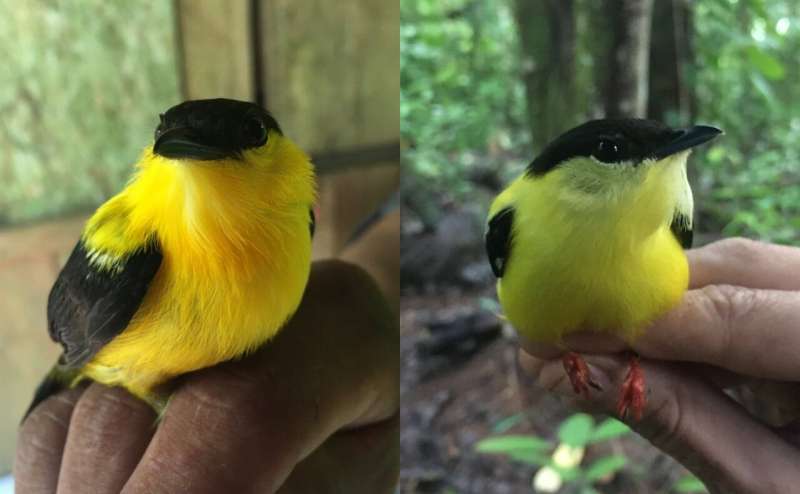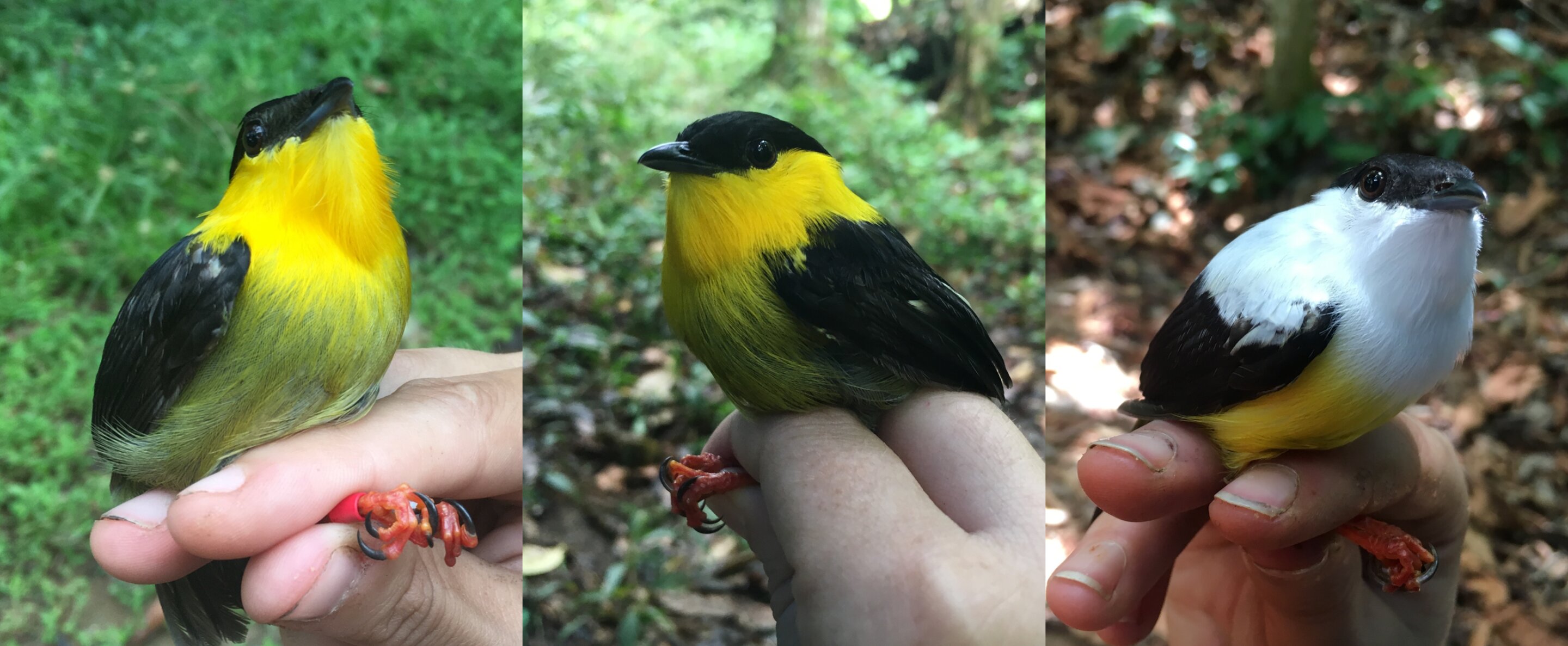We often think of species as separate and distinct, but sometimes they can interbreed and create hybrids. When this happens consistently in a specific area, it forms what’s known as a hybrid zone. These zones can be highly dynamic or remarkably stable, and studying them can reveal key insights into how species boundaries evolve—or sometimes blur.
In a new study published in Evolution, researchers at the University of Illinois Urbana-Champaign describe a hybrid zone between two manakin species in Panama that has overall remained relatively stable over the past 30 years.
Hybrids resulting from mixed-species breeding are not uncommon; consider, for example, the mule (horse-donkey) or the liger (lion-tiger). However, many of these classic examples of hybrids are typically infertile and exist only as first-generation crosses. In contrast, along the western edge of Panama, against the Caribbean Sea, a long-term hybrid zone exists between two species of birds, the golden-collared manakin and the white-collared manakin.
Previous research conducted nearly 30 years ago on this hybrid zone found that the genomic center—where the population’s genome is nearly 50% white-collared DNA and 50% golden-collared DNA—did not overlap with the phenotypic transition zone, the area where the population visually transitions from more golden-collared plumage to more white-collared. The previous study had found that these two areas were about 60 km apart, and until recently, it was unclear whether there had been any changes over the years.
Kira Long, a former graduate student in Jeff Brawn’s lab, now a postdoctoral researcher at the University of Idaho, and her team decided to compare the current population of manakins in the hybrid zone to those from the previous study approximately 30 years ago. Doing so would allow the researchers to see whether the genomic center or the phenotypic transition zone has moved over time, and how stable the genomic and phenotypic traits are across the population.
“Currently, hybrids at the genomic center look phenotypically almost identical to the golden-collared manakins,” explained Long. “They have the golden yellow collar and dark green belly of golden-collared manakins. What’s crazy is that these hybrids are the most genetically mixed between white and golden-collared manakins, yet they look almost identical to the golden-collared parents, whereas the birds that visually look the most mixed have genetically a majority of white-collared DNA.”
Long’s team includes Illinois researchers Jeff Brawn, a professor emeritus of natural resources and environmental sciences, Julian Catchen (CIS/GNDP), an associate professor of integrative biology, and his former graduate student Angel Rivera-Colón, as well as collaborators from the University of Maryland College Park and the Smithsonian Institution.
Over four years, the team captured and took blood samples from over 600 manakins across different areas of the hybrid zone. The blood samples were sequenced using RADseq to examine thousands of genomic markers across the genome. These were then compared to samples taken from museum specimens housed at the Smithsonian Institution that were used in the original, older study. The team also measured phenotypic traits of the wild-caught and historical birds, known to differ between golden-collared and white-collared manakins, including feather coloration and length.

After comparing the historical and wild-caught bird genomes, the researchers found that the genomic center of the population had not moved in approximately 30 years. Less than 3% of the genomic markers tested had changed over time. Furthermore, the phenotypic transition zone had also remained stable, with only one trait—belly color—having shifted in location over time by about 10 km.
“What this means is that if you went to the same location in the phenotypic transition of the hybrid zone 30 years ago, you would see birds with more yellow bellies, whereas if you went to that same spot now you would see birds with more olive-colored bellies,” said Long. “The hybrid bellies are essentially getting darker over time. This may mean that there is some sort of selection for the green bellies in these populations where it is spreading.”
Hybrids have varying success in the animal kingdom depending on the species that are mixed. There is a hybrid zone of cottonwood trees, for example, that is extremely stable, only moving slowly during interglacial periods, according to Long. Hybrids of many species often have less fitness than the parental species because they are too intermediate in their traits, but sometimes hybrids are able to capitalize on this and find success, by making use of environmental niches that are between the optimums for the parental species.
According to Long, the population of hybrid manakins seems to be doing just fine, which may explain why the hybrid zone is so stable. While there is evidence of decreased hatching success in the hybrids—which Long says will be published soon in her next article—she notes that this is essentially nature filtering out the genetic combinations between the white-collared and golden-collared manakins that do not work. Once they hatch, the hybrids’ survival appears similar to the parental species, and they do not seem to have issues finding mates, according to Long.
The next big steps for this system is to determine if female choice is affecting selection for specific hybrid phenotypes and determine the underlying genomic architecture of these traits, Long said. This may provide insight into why hybrids typically resemble the golden-collared species and why the transition zone for belly color is shifting while other phenotypic traits remain relatively stable among hybrids.
“It’s thought the females prefer golden-collared colors, and that might be why the more olive belly color, which is a trait of golden-collared manakins, is spreading in the hybrids,” said Long. “We have indirect evidence for this, but it’s never been formally tested, so it would be great to get that last piece of the puzzle.”
More information:
Kira M Long et al, Ongoing introgression of a secondary sexual plumage trait in a stable avian hybrid zone, Evolution (2024). DOI: 10.1093/evolut/qpae076
Citation:
Researchers find genetic stability in a long-term Panamanian hybrid zone of manakins (2024, June 26)
retrieved 26 June 2024
from https://phys.org/news/2024-06-genetic-stability-term-panamanian-hybrid.html
This document is subject to copyright. Apart from any fair dealing for the purpose of private study or research, no
part may be reproduced without the written permission. The content is provided for information purposes only.

